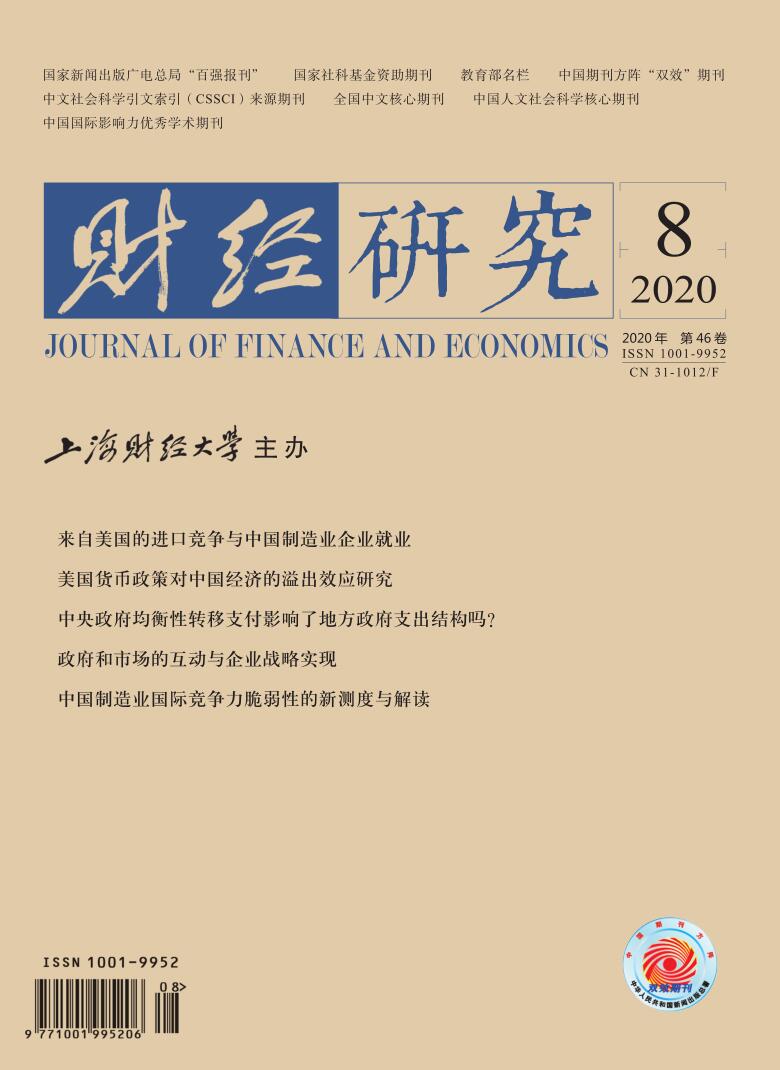[1] Li L, Bai D H, Xian G M. How does outward foreign direct investment affect home-country employment: Based on China’s micro-level enterprises database[J]. Economic Research Journal, 2016, (8): 144-157. (In Chinese)
[2] Mao Q L, Xu J Y. Input trade liberalization and manufacturing job dynamics[J]. Economic Research Journal, 2016, (1): 69-83. (In Chinese)
[3] Mao Q L, Xu J Y. Does input trade liberalization raise firms markups: Evidence from China[J]. China Economic Quarterly, 2017, (2): 485-524. (In Chinese)
[4] Mao R S. A study on the links between real exchange rate change and employment adjustment in Chinese industrial sectors[J]. Economic Research Journal, 2013, (3): 56-69. (In Chinese)
[5] Wei H, Li X Q. Protection of intellectual property rights and employment growth of innovation firm in China[J]. Chinese Journal of Population Science, 2017, (4): 41-53. (In Chinese)
[6] Wei H, Lin X D. Quality import products and innovation of Chinese enterprise[J]. Statistical Research, 2017, (6): 16-26. (In Chinese)
[7] Wei H, Zhang Y P, Lian H J. The impact of China’s export on the employment structure in destination enterprises: Based on the sample of destination enterprises[J]. Chinese Journal of Population Science, 2019, (1): 16-32. (In Chinese)
[8] Acemoglu D, Akcigit U, Alp H, et al. Innovation, reallocation, and growth[J]. American Economic Review, 2018, 108(11): 3450-3491. DOI:10.1257/aer.20130470
[9] Aghion P, Bloom N, Blundell R, et al. Competition and innovation: An inverted-U relationship[J]. Quarterly Journal of Economics, 2005, 120(2): 701-728.
[10] Amiti M, Konings J. Trade liberalization, intermediate inputs, and productivity: Evidence from Indonesia[J]. American Economic Review, 2007, 97(5): 1611-1638. DOI:10.1257/aer.97.5.1611
[11] Autor D H, Dorn D, Hanson G H. The china syndrome: Local labor market effects of import competition in the United States[J]. American Economic Review, 2013, 103(6): 2121-2168. DOI:10.1257/aer.103.6.2121
[12] Autor D H, Dorn D, Hanson G H. The China shock: Learning from labor market adjustment to large changes in trade[R]. NBER Working Paper No.21906, 2016.
[13] Autor D H, Dorn D, Hanson G H, et al. Trade adjustment: Worker-level evidence[J]. The Quarterly Journal of Economics, 2014, 129(4): 1799-1860. DOI:10.1093/qje/qju026
[14] Balsvik R, Jensen S, Salvanes K G. Made in China, sold in Norway: Local labor market effects of an import shock[J]. Journal of Public Economics, 2015, 127: 137-144. DOI:10.1016/j.jpubeco.2014.08.006
[15] Bernard A B, Eaton J, Jensen J B, et al. Plants and productivity in international trade[J]. American Economic Review, 2003, 93(4): 1268-1290. DOI:10.1257/000282803769206296
[16] Bernard A B, Jensen J B, Schott P K. Survival of the best fit: Exposure to low-wage countries and the (uneven) growth of U.S. manufacturing plants[J]. Journal of International Economics, 2006, 68(1): 219-237. DOI:10.1016/j.jinteco.2005.06.002
[17] Bloom N, Draca M, Van Reenen J. Trade induced technical change? The impact of Chinese imports on innovation, IT and productivity[J]. The Review of Economic Studies, 2016, 83(1): 87-117. DOI:10.1093/restud/rdv039
[18] Brandt L, van Biesebroeck J, Wang L H, et al. WTO accession and performance of Chinese manufacturing firms[J]. American Economic Review, 2017, 107(9): 2784-2820. DOI:10.1257/aer.20121266
[19] Brandt L, van Biesebroeck J, Zhang Y F. Creative accounting or creative destruction? firm-level productivity growth in Chinese manufacturing[J]. Journal of Development Economics, 2012, 97(2): 339-351. DOI:10.1016/j.jdeveco.2011.02.002
[20] Croizard J L, Ranjan P, Rodriguez-Lopez A. Trade costs and job flows: Evidence from establishment-level data[J]. Economic Inquiry, 2015, 53(1): 173-204. DOI:10.1111/ecin.12139
[21] De Loecker J, Goldberg P, Khandelwal A K, et al. Prices, markups and trade reform[R]. NBER Working Paper No.17925, 2012.
[22] Domowitz I R, Hubbard R G, Petersen B C. Business cycles and the relationship between concentration and price-cost margins[J]. RAND Journal of Economics, 1986, 17(1): 1-17. DOI:10.2307/2555624
[23] Feenstra R C, Ma H, Xu Y. US exports and employment[J]. Journal of International Economics, 2019, 120: 46-58. DOI:10.1016/j.jinteco.2019.05.002
[24] Feenstra R C, Sasahara A. The ‘China shock’, exports and U.S. employment: A global input-output analysis[J]. Review of International Economics, 2018, 26(5): 1053-1083. DOI:10.1111/roie.12370
[25] Feenstra R C, Weinstein D E. Globalization, markups and U.S. welfare[R]. NBER Working Paper No.15749, 2010.
[26] Fieler A C, Harrison A E. Escaping import competition in China[R]. NBER Working Paper No.24527, 2018.
[27] Greenland A, Lopresti J. Import exposure and human capital adjustment: Evidence from the U.S.[J]. Journal of International Economics, 2016, 100: 50-60. DOI:10.1016/j.jinteco.2016.02.002
[28] Haltiwanger L, Foster L, Krizan C J. Aggregate productivity growth: Lessons from microeconomic evidence[A]. Dean E, Harper M, Hulten C. New directions in productivity analysis[C]. Chicago, IL: University of Chicago Press, 2001.
[29] Kamal F, Lovely M E. Import competition from and offshoring to low-income countries: Implications for employment and wages at U.S. domestic manufacturers[J]. Journal of Asian Economics, 2017, 48: 100-119. DOI:10.1016/j.asieco.2016.10.010
[30] Kasahara H, Liang Y W, Rodrigue J. Does importing intermediates increase the demand for skilled workers? Plant-level evidence from Indonesia[J]. Journal of International Economics, 2016, 102: 242-261. DOI:10.1016/j.jinteco.2016.07.008
[31] Melitz M J, Ottaviano G I P. Market size, trade, and productivity[J]. The Review of Economic Studies, 2008, 75(1): 295-316. DOI:10.1111/j.1467-937X.2007.00463.x
[32] Mendez O. The effect of Chinese import competition on Mexican local labor markets[J]. The North American Journal of Economics and Finance, 2015, 34: 364-380. DOI:10.1016/j.najef.2015.09.009
[33] Mion G, Zhu L K. Import competition from and offshoring to China: A curse or blessing for firms?[J]. Journal of International Economics, 2013, 89(1): 202-215. DOI:10.1016/j.jinteco.2012.06.004
[34] Schumpeter J A. Capitalism, socialism, and democracy[M]. New York: Harper, 1950.
[35] Tybout J R. Plant- and firm-level evidence on “new” trade theories[A]. Choi E K, Harrigan J. Handbook of international trade[M]. Malden: Blackwell Publishing Ltd, 2003.





 6464
6464  6067
6067

